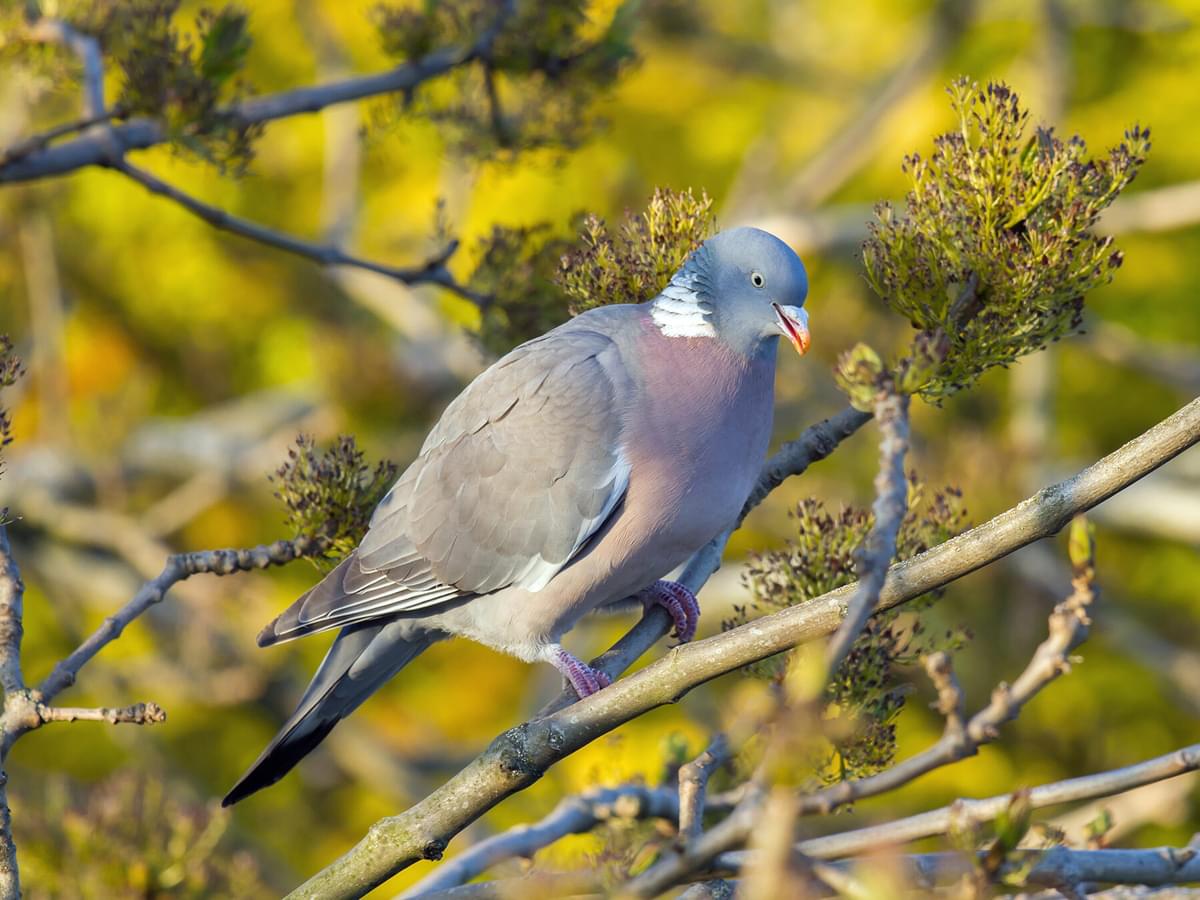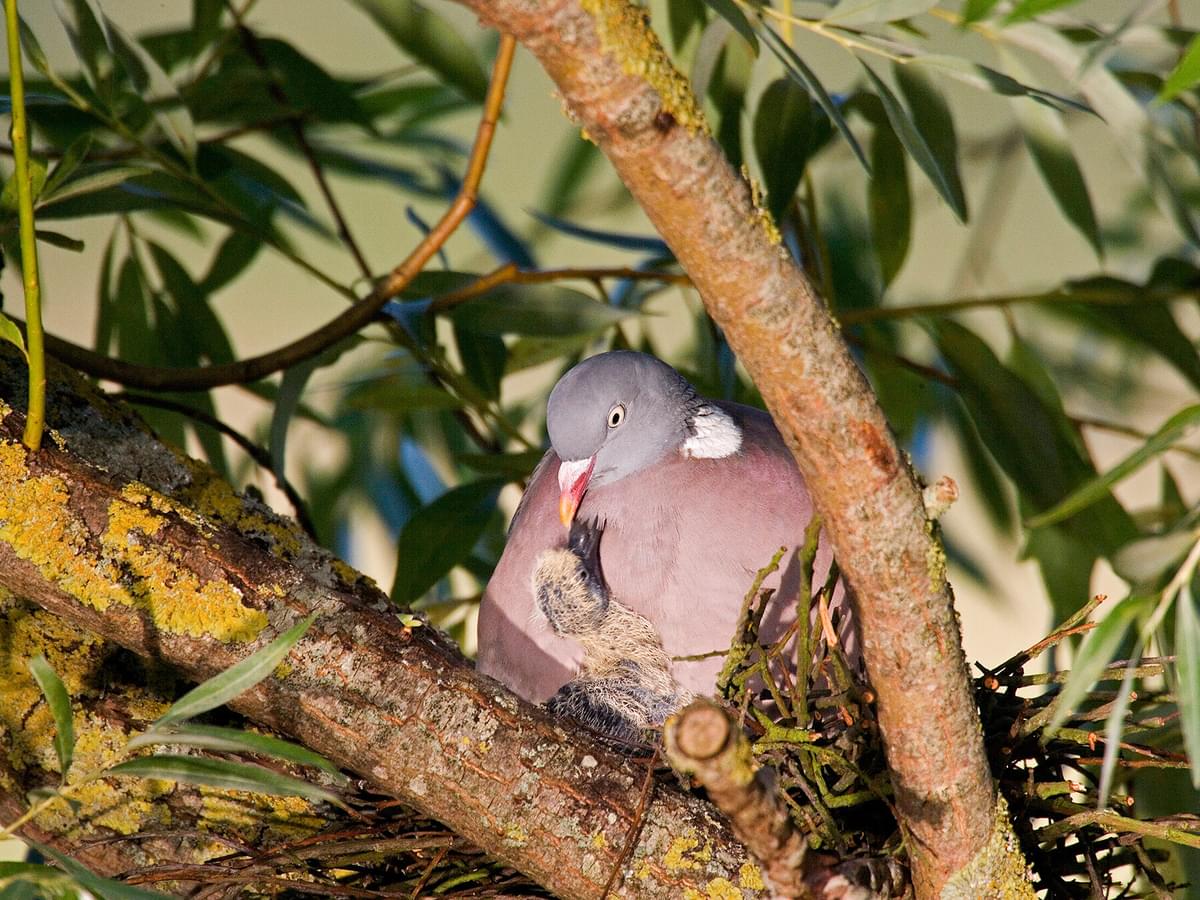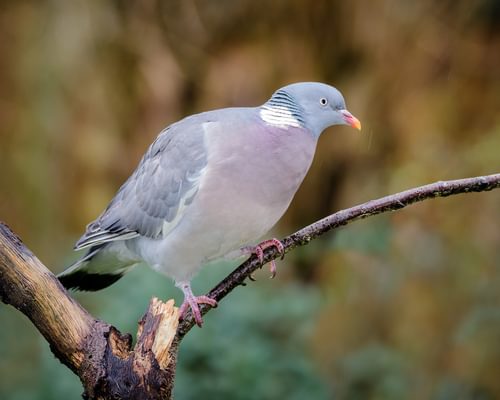Wood Pigeons (Columba palumbus) are one of the most common birds spotted in parks and gardens throughout the UK. Not only are they visually easy to identify, but their familiar cooing sound heard in the countryside is also highly distinctive.
These large pigeons are relatively shy, but they are generally much more approachable in towns and cities, where their population numbers are increasing.
Pigeons, on the whole, get a bit of a reputation of being greedy scavengers and eating pretty much anything and everything due to the diet of rock doves (feral pigeon), but what do wood pigeons eat?
Wood Pigeons have a predominately vegetarian diet consisting of leaves, seeds, berries, fruits, flowers and root crops. Although they are mainly vegetarian, they'll occasionally eat various invertebrates, including earthworms, slugs, spiders and beetles.
Many people consider woodpigeons to be greedy birds, as they are commonly seen throwing their weight around, dominating bird feeders in gardens, meaning that smaller birds miss out.
In some populations of woodpigeons, over 100 different types of crops have been identified in their diets, but the most common include wheat, barley, oats, maize, rape, cabbages and sprouts.
In the UK, it's estimated that wood pigeons cause at least £3 million worth of damage to crops each year, due to their fondness of crops and cereal grains in their diet.

A common wood pigeon eating seeds from a tree
What do wood pigeons eat on the lawn?
The majority of the time that wood pigeons are feeding on the lawn, they are feeding on grass seed. Sometimes they'll also be foraging for insects, but this is less common behaviour.
How do wood pigeons find food?
Wood Pigeons get most of their food from foraging on the ground. They find a suitable place and walk about pecking at the ground at foods like seeds, buds or crops. They can easily spend a couple of hours feeding at one location.
Although most of their food is taken from the ground, wood pigeons are actually pretty agile when feeding in trees.

Wood Pigeon foraging for food on grass
What time of day do wood pigeons feed?
During the summer, wood pigeons generally feed three times a day. First thing in the morning, mid-morning, and once again in the evening, just before it gets dark. They forage for most of the day in the winter due to fewer daylight hours.
What do wood pigeons eat in the winter?
In the winter, wood pigeons favour oilseed rape. This high-oil content food is great for providing them with a rich energy source, as well as aiding with their bones and joints.
As well as oilseed rape, woodpigeons also heavily rely on fruits and seeds of trees, as well as nuts, berries and grass seeds. This is also the case during autumn.

Wood Pigeons foraging for grains in a field
What do wood pigeons eat in the summer?
During the summer, wood pigeons mainly consume crops and grains, including winter-sown cereals, barley, wheat, rape seeds and beans. In spring, stunted rape, clover and peas are commonly consumed.
What do baby wood pigeons eat?
Wood pigeons feed their babies on a milk-like liquid, which is secreted from their crops. This liquid contains high protein levels, which is essential to the development of the squabs (pigeon chicks).
This 'crop milk' is made up of partially digested food sat in their crop, which is then regurgitated into the beaks of the chicks in the nest.
It's thought that this is why wood pigeons have a relatively high success rate in raising their young, as chicks don't need specific insects or seeds, they are simply eating the diet of an adult, just in another form.

Woodpigeon feeding a chick (squab) in the nest
How big is the crop of a wood pigeon?
Compared to many other birds, wood pigeons have a pretty significant sized crop.
Typically, the weight of food in a wood pigeon's crop is around 70 grams. In some cases, weights of up to 155 grams have been recorded with crops including 725 ivy berries, 758 wheat grains, 30 cherries and 38 acorns.
This is one of the reasons that wood pigeons appear 'greedy'. It's because they can eat a lot of food in one sitting, which is then stored and digested later.
How do wood pigeons digest their food?
Once woodpigeons have consumed a load of food, the food goes from the crop into the gizzard, which is a muscular organ that breaks down all the plant material by grinding it down.
This digestion process takes place whilst they are perched in a tree or resting somewhere - this is one of the main reasons you'll notice that wood pigeons are seen to be inactive and perched.

Wood Pigeons spend a lot of time perched whilst digesting their food
Why do wood pigeons dig on gravel?
Wood pigeons can often be seen digging on gravel, and with most other birds, you'd assume they're looking for worms and other insects, but wood pigeons are finding small bits of grit to help break down their food to aid the digestive process.
What should I feed wood pigeons?
Wood Pigeons aren't that fussy when it comes to feeding. However, they do have a particular fondness for sunflower hearts, peanuts and bird seed mixes.

A wood pigeon eating seeds from a bird table
What seeds do wood pigeons eat?
One of the best seeds to feed wood pigeons is sunflower hearts. They will pretty much eat most seeds offered to them, including any wild bird mix.
What do wood pigeons drink?
Wood Pigeons drink water, and unlike many other birds, they consume quite a lot of it. This is because the main foods in their diets often don't contain much water content.
When it comes to drinking water, wood pigeons differ once again from most other birds. Most birds get a beak full of water and then tip their heads back to swallow it.
On the other hand, Wood Pigeons stick their beaks in the water and suck it all up, just like using a straw. This can be pretty entertaining to watch if you get the chance to do so.
Wood Pigeons are familiar sights at bird baths and will drink regularly from them when they feel comfortable doing so.
It's best to regularly clean out bird baths and provide fresh water every so often. Not only will this keep the birds coming back, but it also helps prevent disease.

Wood Pigeon drinking water from a pond
How do I attract wood pigeons to my garden?
Wood Pigeons are extremely easy birds to attract to the garden. They are pretty happy with a water source for drinking, such as a bird bath, and a bird table or flat tray feeder full of seeds (or sunflower hearts).
Do wood pigeons use bird feeders?
Wood Pigeons frequently use bird feeders. Because of their bulky frames, they only tend to use bird tables and flat feeders, like tray feeders.
Many people consider wood pigeons to be somewhat of a pest at their feeders, as they can eat a lot and also discourage smaller birds from using the feeders.
We recommend using a multitude of different feeders to keep all of the birds happy in the garden. Wood Pigeons tend to steer clear of hanging feeders, although that's not to say they won't give it a try!

A cheeky wood pigeon using a bird feeder designed for small garden birds
Wood Pigeon Diet FAQs
Is it OK to feed wood pigeons?
It's completely fine to feed wood pigeons, and in fact, you can help them out by providing them with the right foods. Cabbage, peas, sprouts and grains are all excellent foods that you can leave on the ground or on bird tables.
What do wood pigeons not eat?
Although they'll still eat them, wood pigeons are less keen on nyjer seed and suet balls.
On the whole, wood pigeons are one of the less fussy birds you'll get in your garden, so there's not a lot they won't eat.
Also, as with other birds, try not to feed wood pigeons bread. They will take it happily, but it will fill them up whilst providing little to no nutritional value.
Do wood pigeons eat meat?
If they are hungry enough, wood pigeons may eat meat and insects. However, they mainly consume seeds and grains to provide them with the micronutrients their diets require to keep them healthy.
Do wood pigeons eat fruit?
Fruit is a relatively significant part of a wood pigeons diet. They like to eat strawberries, gooseberries, cherries, currants, plums and apples.
Do wood pigeons eat mealworms?
Occasionally, wood pigeons will eat mealworms, however this is relatively uncommon and usually only when other preferred food sources are scarce.

